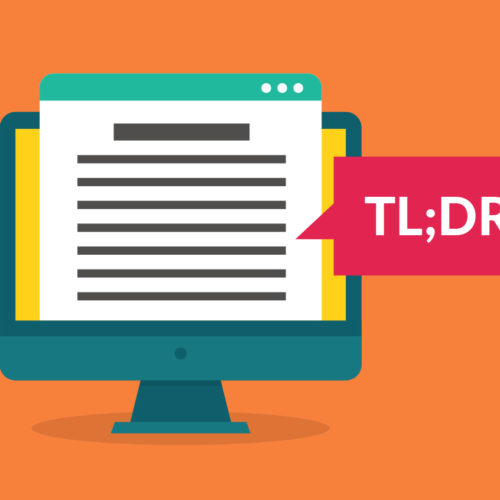Keep Calm and Write On: A Guide on How to Handle a Negative Online Review
Imagine this… You sit down at your computer one fine morning, coffee cup in hand, and begin to make your online rounds. You check all the usual things: social media, analytics, blogs, and email – until you gasp in horror and stop in your tracks. Someone has left you a negative online review! While this is a shocking and upsetting experience, you’re not alone. Ever heard the saying… Haters Gon’ Hate? The truth is that any business that works with customers on a regular basis is bound to get a bad online review or two, and while it’s never a fun situation to be in the middle of, a negative online review doesn’t have to be a catastrophe. HelpScout reports that for every one customer who lodges a complaint, 26 customers stay silent. Kind of sucky: but a fact. Although it feels bad when it happens, you won’t be (anything close to) scarred for life. By the end of today’s post, you’ll actually learn that it could be a good thing! And negative online reviews have happened to us too: so I can tell you, personally, that you’ll come out of the fire refined. 5 Key Tips You Can Put to Immediate Use in Handling A Negative Online Review In five steps, here’s a simple breakdown of what to do post-apocalypse (after you’ve received that yucky online review). 1. Stay calm Refer to our Keep Calm & Write On graphic. (Save it, print it out, hang it up, do whatever you like.) You’re a business owner: you work hard for your company, and it’s understandable that finding a negative online review would make you feel hurt, sad, and even angry. If this happens, though, the first thing to do is to stay calm. Nothing good ever came from blowing up at a negative online review, and you’re liable to do irreparable damage to your company if this is the path you choose. As a general rule, it takes 12 good experiences with a company to make up for one negative experience, so you could be digging yourself a big hole with your customers if you fly off the handle before thinking through things. Instead of being reactionary, take a step back from the review and give yourself a bit of time to consider the situation. Begin by sizing up the content of the review. Is it factually correct? Is there a way to address or resolve the problem for the customer? Does the review offer insight into something your company could do well to fix, anyway? For example, if a customer at your restaurant complains that it took 30 minutes to get a glass of water after sitting down, and you were indeed tragically understaffed that night, there’s a simple solution. In this case, the correct path would be to apologize to the customer and offer a comped or discounted meal the next time they return. Once you’ve addressed the complaint, you could even consider hiring more staff or implementing different protocols to prevent that type of situation from happening again. If the report is factually inaccurate, however, your approach will be different. While malicious reviews don’t happen very often, they do happen. Luckily, there’s a way to deal with them. If someone is making dishonest or defamatory statements about your company, it’s within your rights to ask the third-party review site to remove the comment. This is true regardless of whether the review is on Yelp, Facebook, or Google. Keep in mind that getting reviews removed can be an extensive and arduous process, so it’s one to undertake carefully. First of all, you’ll need to provide proof that shows the review is factually inaccurate. If you can’t do this or can’t wait for the third-party site to decide on the review, set the record straight in the comments section below the review. Just remember to be neutral and professional to avoid making the situation worse. Take it from Amy’s Baking Company – which won catastrophic web-wide recognition when the owners repeatedly and aggressively lashed out at a displeased reviewers on Yelp. As if the above wasn’t bad enough… So, there you go on a brief rundown of what not to do. Now, let’s look at best next action steps. 2. Take Action/Offer a Solution Customers don’t often go out of their way to write negative reviews for no reason, so it’s in your best interest to heed the review and do everything in your power to rectify the situation. Your first case of action here is to determine if this is a legitimate customer – because you can only service the legit negativity. We hate to say it, but yes, there are people out there who will leave fake negative reviewers (are either paid by competitors, are the competitor themselves, are are acting out of personal angst). If you know this is a stranger, and not a legitimate complainer: well, here’s one scenario you could take inspiration from. I’m going to tell you a little story. The Story of Jane, Bill, & Will: (Or, the Art of Handling the Fake Negative Review) Let me run you through a story about what we’ll call Bill the Fake Reviewer Writer. Bill heard of a made-up negative story about a company, word-of-mouth, from Jane. Jane was fired from her company just that week. At Jane’s very frequent pushing, Bill went and published a fake review on Jane’s company. He was amped up by Jane and wrote a lot of angry words, calling the company names and even going as far as to put libel on the company owner. It was a weekend and late in the evening. Still, the company social manager was online and saw the angry posts being left by Bill; he alerted the company CEO within minutes of it happening. Let’s call that CEO Will. Will took a breather (see #1). After ten minutes, he immediately replied to Bill, cordially starting with hello. Then he stated facts: 1) we’ve never served you and 2) please provide proof on and who is spreading information about the things you’re currently stating. Bill couldn’t, told by Jane … Read more









